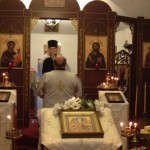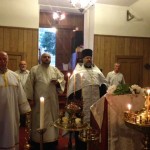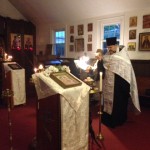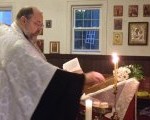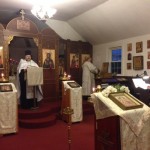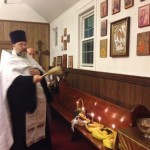On August 18, Vigil of the Transfiguration of the Lord, St. George Church’s Rector, Archpriest Igor Tarasov served Great Vespers of the feast in our temple. This service was scheduled instead of the festal Liturgy because our Rector was summoned to serve in St. Nicholas Cathedral.
Following the service Fr. Igor preached a sermon:
“Feast of the Transfiguration is one of the very important among the holy days. Today we celebrate a miraculous change which was manifested by our Lord Jesus Christ to His disciples on the Mount Tabor. Taking Peter, James and John to that high mountain, He transfigured before them. As the Gospel states, “His face shone like the sun, and His clothes became as white as the light” (Mt. 17, 2). Before that they knew Jesus to be a great Teacher, a wonderworker, the Messiah promised by the Old Testament. But they did not fully realize that He was the Son of God and God Himself. At the Mount Tabor Jesus revealed who He really was. Thus the Apostles could see the glory of the true God, the light shining from the divine nature.”
“No one ever saw God. God’s essence and nature is incomprehensible to our limited mind. However, God revealed Himself and showed some part of His nature to certain holy people. In the times before Christ, God appeared to Moses and Elijah. Holy Prophet Moses could see God. God appeared to Moses as the burning bush or a cloud. But God also showed Moses Himself in a special, mystical way, as the Scripture tells “from behind”, because a man cannot see God and live. Holy Prophet Elijah was also blessed by seeing God who revealed Himself in a breath of the calm wind. These were the men of the Old Testament whom God blessed with His appearance. And it was not accidental that those two holy men appeared on the Mount Tabor to converse with Jesus when He transfigured before His disciples. Moses and Elijah represented the Law and the Prophets of the Old Testament which were fulfilled in Jesus.”
“With the coming of our Lord Jesus Christ into the world, God revealed Himself in a very comprehensible and accessible way. He became man, so we could see God in our form. And Transfiguration of our Lord had to teach His disciples of the mystery of the union of human and divine natures in Christ.”
“There are many different ideas about God. Some philosophers or other intelligent people may imagine God to be some universal force or some worldly order. But such God is not personal. We believe that God is a Person, the one to whom we can refer, with whom we can speak. And in Jesus Christ who became one of us, a partaker of the human nature, we find such personal God much easier. Also, through His taking up the human nature and interweaving it with His divine nature, we may become the partakers of the divinity. As we all created in the image of God, through Christ we may acquire the likeness of God.”
“This is what is called by the Fathers the process of deification or theosis. Human nature becoming divine. This teaching was elaborated by the Holy Fathers of the III and IV centuries, especially by St. Athanasius of Alexandria. Interestingly that this teaching is not very much remembered or used by Protestants and Roman Catholics, by Western Christians. It is known that today’s Western world likes to talk about the dignity of man and to extol humanity. But this is a secular way of praising the human nature, the so-called humanism. It desires to serve man and to forget about God. It strives to praise human nature with all its weaknesses and passions, a nature corrupted by sin. Our Eastern Church adheres to the teaching of the Fathers which extols human nature in a Christian way. We say that man is called to become like God not by being proud and sinful, but through the pious life, through the partaking of divine nature, through the acquiring of divine grace in our Lord Jesus Christ. What could be more honorable for a man than an idea of becoming like God? But that way of deification is the way of piety, spiritual and sacramental life in our Lord Jesus Christ, life in which we hear the beloved Son of the Father. It is the way of Transfiguration, a movement from below to above.”
“We know that many people are concerned about progress. At least, for the last century, the notion of progress became very popular and important for our society. Many things and even values are being sacrificed in order to follow progress. But progress is a movement ahead, a movement forward. But what we, Christians, really need is a movement from below to above. And this is not progress, but Transfiguration! This was noticed a century ago by our New Martyr Hilarion (Troitsky). We need Transfiguration, not progress. This process will lead us above and will help us to recognize our true destiny – to be with God in heaven and to become partakers of the Divine.”
After the Vespers the Rector performed traditional blessing of fruits.
Next day, on the feast of Transfiguration of the Lord, Fr. Igor celebrated the Divine Liturgy at St. Nicholas Cathedral. Following the Scripture readings he preached the same homily as at Vespers on the night before, but in the Russian language. 5 of our parishioners came to the Cathedral to participate in festal Liturgy. After the service Fr. Igor blessed fruits for the multitudes of the Cathedral parishioners.
Our Rector and five our parishioners continued celebration of the feast having a luncheon at the nearby restaurant.

